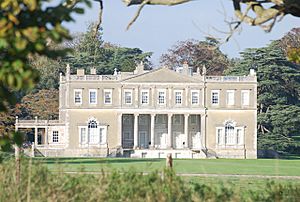Humphrey Sturt facts for kids
Humphrey Sturt (born around 1724, died 1786) was an important person in British history. He owned a lot of land and was also an architect. He served as a politician in the House of Commons for 30 years, from 1754 to 1784.
Contents
Early Life and Family Background
Humphrey Sturt was the son of Humphrey Sturt and Diana Napier. His mother, Diana, was from a very old family. She was a great-great-granddaughter of Sir Nathaniel Napier. Sir Nathaniel was the person who built Crichel House. This is how the house later came into the Sturt family.
Humphrey Sturt went to Queen's College, Oxford when he was 16 years old. He married Mary Pitfield in London in 1756. Humphrey Sturt became very wealthy thanks to his grandfather, Sir Anthony Sturt. His grandfather was a successful businessman. He was also an alderman in the City of London and supplied food to the Navy.
Political Career and Public Service
Humphrey Sturt was the Lord of Horton Manor, which meant he owned a lot of land there. He became a Member of Parliament (MP) for Dorset in 1754. An MP is someone elected to represent an area in the British Parliament. He was elected without anyone running against him.
He was re-elected four more times without opposition. This shows he was very popular in his area. He served as an MP until 1784. After 30 years, he decided not to run for election again.
Changing the Landscape: Estates and Projects
Humphrey Sturt was known for changing the look of his estates. He especially worked on Crichel House in the village of Moor Crichel. He wanted the house to have a grand setting.
At another place called Horton, he had already built a large lake. It was about 200-acre (0.81 km2) big. He decided to create another lake at Moor Crichel. The only problem was that the village cottages were in the way.
The Village Under the Lake
To make his vision happen, the entire village of Moor Crichel had to move. The old village site is now under the waters of a large, curved lake. The villagers moved to a new place called New Town in Witchampton. Only the church stayed behind, which was rebuilt later. The area around the lake became a beautiful, planned park.
Improving Agriculture
Humphrey Sturt also had many new ideas for farming. He used these ideas on his lands in the Crichels. He also used them on Brownsea Island in Poole Harbour. He even used steam power to thresh crops. Threshing is separating grain from the plant. He also brought a lot of manure to Brownsea Island. This helped him plant new crops and improve the land.
After Humphrey Sturt died, his estates went to his younger son, Charles Sturt.
Horton Tower: Sturt's Folly
Humphrey Sturt designed an interesting building called Horton Tower. It is in Horton, Dorset. It was built around 1750. This tower is also known as Sturt's Folly. A "folly" is a building built mainly for decoration, not for a practical purpose.
Horton Tower is very tall, about 140 feet (43 meters) high. It has six stories. It even had a fireplace halfway up! A map from 1765 called it an "Observatory." However, a local story says Sturt built it for a different reason. He supposedly built it so he could watch local fox hunts. He could do this from the tower when he was too old to ride his horse.
Humphrey Sturt passed away on October 20, 1786. He and his wife had many children. They had ten sons and five daughters. One of his sons was Charles Sturt. Charles Sturt was the father of Henry Charles Sturt.



